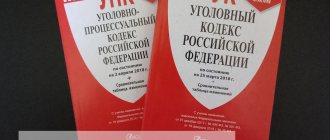As a lawyer with many years of practice, I often encounter crimes committed in connection with street conflicts. People often come to me with the question, what to do if you “told” an inappropriate neighbor? Or when returning home from work, he met a hooligan who was the first to get into a fight, but in the end he himself ended up in a hospital bed. The article for causing grievous bodily harm provides for different degrees of punishment. I will talk about penalties for such crimes below.
Let's consider the corpus delicti provided for in Part 1 of Article 111 of the Criminal Code of the Russian Federation.
- Object: human somatic and mental health.
- Objective side: the action or inaction of the guilty person, as a result of which the guilty person suffered serious harm to health. Article 111 of the Criminal Code of the Russian Federation defines this harm:
- loss of the ability to see, speak, hear;
- loss of an organ (or loss of its function);
- completion of pregnancy;
- the appearance of mental disorders;
- drug addiction or substance abuse;
- irreversible facial disfigurement;
- permanent loss of ability to work by 1/3 or more (or absolute loss of professional ability to work).
Medical criteria for determining the severity of harm are recorded in Order of the Ministry of Health and Social Development of the Russian Federation No. 194n dated April 24, 2008 .
- Subject: a sane individual who has reached the age of 14.
- Subjective side: guilt in the form of direct or indirect intent.
The law does not define possible methods of exposure: in most cases, harm to health is caused due to physical impact, using weapons, as well as chemical methods.
Qualifying features aggravating this act are:
- infliction of injury against a subject in connection with his official activities or the performance of public duty;
- committing a crime against a child or an individual who is in a defenseless state (as well as in a particularly cruel manner and with torment for the victim);
- a method of committing a crime that is dangerous to others;
- committing a crime for reward;
- hooligan motives;
- committing an act motivated by political, ideological, racial or other hostility;
- desire to remove the victim's organs or tissues;
- use of weapons or objects used as weapons.
Particularly qualifying features provided for in Part 3 of Article 111 of the Criminal Code of the Russian Federation are:
- infliction of serious injury as part of a group of individuals;
- committing a crime against several subjects.
Part 4 of the article in question also establishes criminal liability for causing harm that negligently resulted in the death of the victim.
Serious harm to health
Harm to health, dangerous to human life, creating a direct threat to life
Wound of the head (scalp, eyelid and periorbital region, nose, ear, cheek and temporomandibular region, other areas of the head), penetrating into the cranial cavity, including without damage to the brain; (clause 6.1.1)
Fracture of the vault (frontal, parietal bones) and (or) base of the skull: cranial fossa (anterior, middle or posterior) or occipital bone, or upper wall of the orbit, or ethmoid bone, or sphenoid bone, or temporal bone, with the exception of an isolated external crack bone plate of the cranial vault and fractures of the facial bones: nose, lower wall of the orbit, lacrimal ossicle, zygomatic bone, upper jaw, alveolar process, palatine bone, lower jaw; (clause 6.1.2)
Intracranial injury: crushing of the brain substance; diffuse axonal brain damage; severe brain contusion; traumatic intracerebral or intraventricular hemorrhage; moderate cerebral contusion or traumatic epidural, or subdural, or subarachnoid hemorrhage in the presence of cerebral, focal and brain stem symptoms; (clause 6.1.3)
Wound of the neck penetrating into the lumen of the pharynx or larynx, or the cervical trachea, or the cervical esophagus; injury to the thyroid gland; (clause 6.1.4)
Fracture of the cartilages of the larynx: thyroid or cricoid, or arytenoid, or epiglottis, or corniculate, or tracheal cartilages; (clause 6.1.5)
Fracture of the cervical spine: fracture of the body or bilateral fracture of the arch of the cervical vertebra, or fracture of the tooth of the II cervical vertebra, or unilateral fracture of the arch of the I or II cervical vertebrae, or multiple fractures of the cervical vertebrae, including without dysfunction of the spinal cord; (clause 6.1.6)
Dislocation of one or more cervical vertebrae; traumatic rupture of the intervertebral disc at the level of the cervical spine with compression of the spinal cord; (clause 6.1.7)
Contusion of the cervical spinal cord with impairment of its function; (clause 6.1.8)
A wound of the chest penetrating into the pleural cavity or into the pericardial cavity, or into the mediastinal tissue, including without damage to internal organs; (clause 6.1.9)
Closed damage (crushing, avulsion, rupture) of the organs of the thoracic cavity: the heart or lung, or the bronchi, or the thoracic trachea; traumatic hemopericardium or pneumothorax, or hemothorax, or hemopneumothorax; diaphragm or lymphatic thoracic duct, or thymus gland; (clause 6.1.10)
Multiple bilateral rib fractures with disruption of the anatomical integrity of the chest frame or multiple unilateral rib fractures along two or more anatomical lines with the formation of a movable section of the chest wall like a “rib valve”; (clause 6.1.11)
Fracture of the thoracic spine: fracture of the body or arch of one thoracic vertebra with dysfunction of the spinal cord, or several thoracic vertebrae; (clause 6.1.12)
Dislocation of the thoracic vertebra; traumatic rupture of the intervertebral disc in the thoracic region with compression of the spinal cord; (clause 6.1.13)
Contusion of the thoracic spinal cord with impairment of its function; (clause 6.1.14)
Abdominal wound penetrating into the abdominal cavity, including without damage to internal organs; (clause 6.1.15)
Closed injury (crushing, avulsion, rupture): abdominal organs - spleen or liver, and/or gall bladder, or pancreas, or stomach, or small intestine, or colon, or rectum, or greater omentum, or mesentery colon and (or) small intestine; retroperitoneal organs - kidney, adrenal gland, ureter; (clause 6.1.16)
A wound of the lower back and (or) pelvis penetrating into the retroperitoneal space, with damage to the organs of the retroperitoneum: kidney or adrenal gland, or ureter, or pancreas, or the descending and horizontal part of the duodenum, or the ascending and descending colon; (clause 6.1.17)
Fracture of the lumbosacral spine: body or arch of one or more lumbar and (or) sacral vertebrae with cauda equina syndrome; (clause 6.1.18)
Dislocation of the lumbar vertebra; traumatic rupture of the intervertebral disc in the lumbar, lumbosacral region with cauda equina syndrome; (clause 6.1.19)
Contusion of the lumbar spinal cord with cauda equina syndrome; (clause 6.1.20)
Damage (crushing, avulsion, rupture) of the pelvic organs: open and (or) closed damage to the bladder or the membranous part of the urethra, or the ovary, or the uterine (fallopian) tube, or the uterus, or other pelvic organs (prostate, seminal vesicles, vas deferens); (clause 6.1.21)
A wound to the wall of the vagina or rectum, or perineum, penetrating into the cavity and (or) pelvic tissue; (clause 6.1.22)
Bilateral fractures of the anterior pelvic semi-ring with disruption of continuity: “butterfly”-type fractures of both pubis and both ischiums; fractures of the pelvic bones with disruption of the continuity of the pelvic ring in the posterior section: vertical fractures of the sacrum, ilium, isolated ruptures of the sacroiliac joint; fractures of the pelvic bones with disruption of the continuity of the pelvic ring in the anterior and posterior sections: unilateral and bilateral vertical fractures of the anterior and posterior sections of the pelvis on one side (Malgenya fracture); diagonal fractures - vertical fractures in the anterior and posterior parts of the pelvis on opposite sides (Vollumier fracture); various combinations of bone fractures and ruptures of the pelvic joints in the anterior and posterior sections; (clause 6.1.23)
A wound penetrating the spinal canal of the cervical or thoracic, or lumbar, or sacral spine, including without damage to the spinal cord and cauda equina; (clause 6.1.24)
Open or closed spinal cord injury: complete or incomplete interruption of the spinal cord; spinal cord crush; (clause 6.1.25)
Damage (rupture, avulsion, dissection, traumatic aneurysm) of large blood vessels: aorta or carotid artery (common, external, internal), or subclavian, or axillary, or brachial, or iliac (common, external, internal), or femoral, or popliteal arteries and (or) accompanying main veins; (clause 6.1.26)
Blunt trauma of reflexogenic zones: the larynx area, the carotid sinus area, the solar plexus area, the external genital area in the presence of clinical and morphological data; (clause 6.1.27)
Thermal or chemical, or electrical, or radiation burns of III - IV degree, exceeding 10% of the body surface; third degree burns exceeding 15% of the body surface; second degree burns exceeding 20% of the body surface; burns of a smaller area, accompanied by the development of burn disease; burns of the respiratory tract with symptoms of edema and narrowing of the glottis; (clause 6.1.28)
Frostbite of III - IV degree with an affected area exceeding 10% of the body surface; frostbite of the third degree with an affected area exceeding 15% of the body surface; frostbite of the second degree with an affected area exceeding 20% of the body surface; (clause 6.1.29)
Radiation injuries, manifested by acute radiation sickness of severe and extremely severe degrees. (clause 6.1.30)
Harm to health that is dangerous to human life, causing a disorder of the vital functions of the human body, which cannot be compensated by the body on its own and usually ends in death
Shock of severe (III - IV) degree; (clause 6.2.1)
Coma II - III degree of various etiologies; (clause 6.2.2)
Acute, profuse or massive blood loss; (clause 6.2.3)
Acute cardiac and (or) severe vascular failure, or severe cerebrovascular accident; (clause 6.2.4)
Acute renal or acute liver, or severe acute adrenal insufficiency, or acute pancreatic necrosis; (clause 6.2.5)
Severe acute respiratory failure; (clause 6.2.6)
Purulent-septic condition: sepsis or peritonitis, or purulent pleurisy, or phlegmon; (clause 6.2.7)
Disorder of regional and (or) organ circulation, leading to infarction of an internal organ or gangrene of a limb; embolism (gas, fat, tissue, or thromboembolism) of blood vessels in the brain or lungs; (clause 6.2.8)
Acute poisoning by chemical and biological substances of medical and non-medical use, including drugs or psychotropic drugs, or hypnotics, or drugs acting primarily on the cardiovascular system, or alcohol and its surrogates, or technical fluids, or toxic metals, or toxic gases, or food poisoning causing a life-threatening condition listed in paragraphs 6.2.1 - 6.2.8 of the Medical Criteria; (clause 6.2.9)
Various types of mechanical asphyxia; consequences of general exposure to high or low temperature (heatstroke, sunstroke, general overheating, hypothermia); consequences of exposure to high or low atmospheric pressure (barotrauma, decompression sickness); consequences of exposure to technical or atmospheric electricity (electrical injury); consequences of other forms of adverse effects (dehydration, exhaustion, overexertion of the body), causing a life-threatening condition given in paragraphs 6.2.1 - 6.2.8 of the Medical Criteria. (clause 6.2.10)
Significant permanent loss of general ability to work by at least one third (persistent loss of general ability to work over 30 percent).
The following injuries are considered to be serious harm to health, causing a significant permanent loss of general ability to work by at least one third, regardless of the outcome and the provision (failure) of medical care:
Open or closed fracture of the humerus: intra-articular (humeral head) or periarticular (anatomical neck, sub- and transtubercular), or surgical neck or diaphysis of the humerus; (clause 6.11.1)
open or closed fracture of the bones that make up the elbow joint; (clause 6.11.2)
open or closed fracture-dislocation of the bones of the forearm: fracture of the ulna in the upper or middle third with dislocation of the head of the radius (Montagia fracture-dislocation) or fracture of the radius in the lower third with dislocation of the head of the ulna (Galeazzi fracture-dislocation); (clause 6.11.3)
open or closed fracture of the acetabulum with displacement; (clause 6.114)
open or closed fracture of the proximal femur: intra-articular (fracture of the head and neck of the femur) or extra-articular (intertrochanteric, pertrochanteric fractures), with the exception of isolated fractures of the greater and lesser trochanters; (clause 6.11.5)
open or closed fracture of the femoral diaphysis; (clause 6.11.6)
open or closed fracture of the bones that make up the knee joint, with the exception of the patella; (clause 6.11.7)
open or closed fracture of the tibial diaphysis; (clause 6.11.8)
open or closed fracture of the ankles of both tibias in combination with a fracture of the articular surface of the tibia and rupture of the distal tibiofibular syndesmosis with subluxation and dislocation of the foot; (clause 6.11.9)
compression fracture of two or more adjacent vertebrae of the thoracic or lumbar spine without dysfunction of the spinal cord and pelvic organs; (clause 6.11.10)
open dislocation of the shoulder or forearm, or hand, or thigh, or leg, or foot with rupture of the ligamentous apparatus and joint capsule. (clause 6.11.11)
Persistent loss of general ability to work in other cases is determined in percentages divisible by five, in accordance with the Table of percentages of permanent loss of general ability to work as a result of various injuries, poisonings and other consequences of external causes, attached to these Medical criteria.
Read further:
How to determine the judicial area
Litigation with tour operator for recovery of cost and moral damages
How to recover damages for an injury on the sidewalk in icy conditions
Punishment under Article 111 of the Criminal Code of the Russian Federation
For intentionally causing harm to health under Part 1 of Article 111 of the Criminal Code of the Russian Federation, a citizen can be placed in a colony for up to 8 years. There are no alternative sanctions for the act. If we talk about qualified and especially qualified groups, the punishment is even stricter: for example, if the victim died, the perpetrator faces a prison term of up to 15 years. As an additional punishment, restriction of freedom for up to 2 years may be applied.
The specific terms of imprisonment will depend entirely on the circumstances of the case.
How is the procedure for determining the degree performed?
Determining the severity of harm to health is a procedure that can only be carried out by authorized specialists. To carry out the examination, the victim must be taken to a special medical premises, which contains all the necessary diagnostic equipment.
Based on the analysis, the specialist draws up a detailed report on the results and examination methods used in this case. His report may be used as corroborative evidence in further proceedings in the case or in court.
In some cases, the involvement of additional specialists is required. This is necessary if you have received injuries or damage associated with a violation of specific body functions. For example, in case of abortion or psychological trauma.
As part of medical research, the type of instrument with which the damage was caused, as well as the time period, is established.
Who does the examination
The severity of harm to health is determined by a forensic medical expert. In most cases, it is this specialist who determines the nature of the damage. His powers make him responsible before the law for the accuracy of the information provided.
To carry out such activities, the expert must have appropriate qualifications and accreditation. Lack of necessary skills in the field of medicine and criminal law may lead to the recognition of a specialist’s conclusion as invalid.
Let's give real examples
A resident of the Voronezh region, in a state of alcoholic intoxication, hit her friend in the face several times with a metal scoop. The victim was hospitalized with his injuries, and a criminal case was opened against the woman under clause “z”, part 2, article 111 of the Criminal Code of the Russian Federation. The woman’s repentance and other mitigating circumstances led to the fact that the court sentenced her to only 1.5 years of probation, although the sanction of the article provides for up to 10 years of imprisonment.
And another example.
In January 2021, two residents of the Rostov region, who were intoxicated, attacked three of their acquaintances and severely beat them. The men beat their victims with their hands, feet and various objects found at the crime scene. Due to the beatings, one woman died, two more citizens were taken to the hospital with bodily injuries. In addition, one of the attackers stole the victims’ property for a total amount of 3.5 thousand rubles. The court handed down a guilty verdict , according to which one man was placed in a maximum security colony for 9 years, and the other for 12.5 years.
Consequently, it is quite obvious that citizens suspected or accused of intentionally causing grievous bodily harm need a competent criminal lawyer . A specialist can obtain a suspended sentence or reclassify the act to another article of the Criminal Code of the Russian Federation, providing for less stringent sanctions. The goal of the defense attorney will be to minimize the sentence as much as possible for his client: in some cases, the lawyer can achieve a complete acquittal of the citizen.
Remember that the fate of a person suspected or accused of committing a crime under Article 111 of the Criminal Code of the Russian Federation largely depends on the professionalism of a lawyer and his focus on results. Contact the specialists of Trial Lawyer JSC as early as possible: in this case, we will be able to do more to protect you or your loved ones.
Concept of affect and consequences
This condition is explained in detail at the legislative level. Under the influence of irritating factors, a person develops a state of severe mental distress. These may be the following situations:
- obvious bullying in the presence of others or without them;
- verbal threats to a person or his loved ones;
- extortion against the background of threats;
- expressing racial hatred;
- insults.
In such an emotional state, a person cannot adequately assess the strength of his blow. Therefore, inflicting grievous bodily harm in such situations, according to the article of the Criminal Code of the Russian Federation, does not provide for malicious intent, but does not exempt from liability. This is usually limited to:
- committing damage of this degree in a state of passion requires correctional labor, limited to two years;
- infliction of minor bodily harm – limitation, correctional labor for up to six months.
The data is approximate. The final decision is made by the court. It may not correspond to these data.
What it is
The legal composition of violent actions resulting in harm of moderate severity is recorded in Article 112 of the Criminal Code of the Russian Federation. The key signs and features of such damage are regulated by Decree of the Government of the Russian Federation dated August 17, 2007 No. 522:
- as a result of illegal actions, long-term health problems occur;
- the consequence of causing moderate harm may be a permanent loss of general ability to work (the loss rate should not exceed one third);
- the infliction of moderate bodily harm should not pose a danger to the life of the victim.
When severity cannot be determined
In some cases, it is not possible to determine the severity of the harm caused. This is relevant for the following situations:
- The victim, being in a sane state, does not give personal consent to the examination;
- The damage is so minor that it cannot be identified;
- There are no qualified specialists capable of conducting assessments;
- It is not possible to determine the nature of the damage.
But this does not mean that you cannot contact the police with a statement against the offender.
Criminal punishment for assault
Battery, as well as bodily injury, has its own qualifications established by the Criminal Code of the Russian Federation from July 2021.
For January 2021, two penalties have been established:
- Article 116 of the Criminal Code of the Russian Federation – beating of close relatives or because of national motives.
That is, the number of injured persons should include parents, spouses, children (natural and adopted), grandparents, grandchildren, as well as adoptive parents, guardians and trustees. Also, this qualification can include persons who caused grievous bodily harm due to hooligan or national motives as a result of a fight.
- Article 116.1 of the Criminal Code of the Russian Federation – repeated beating.
The main condition is that the perpetrator must have previously established administrative punishment for causing bodily harm.
Despite the fact that the Criminal Code has divided responsibility for causing harm to health, in some cases punishment can be avoided.
If the beating did not cause irreversible health consequences, or did not fall under any of the qualifying criteria, then criminal liability can be avoided.
However, the culprit will be punished in any case. The penalty may be chosen from the following list:
- 360 hours of compulsory work;
- Two years of isolation from society;
- In case of repeated beatings: Fine up to 40 thousand rubles;
- Mandatory work – 240 hours;
- Correctional work – up to 6 months.
- Mandatory work – 480 hours;
If the court discovers national or hooligan motives, the offender will be sentenced to two years in a penal colony.



